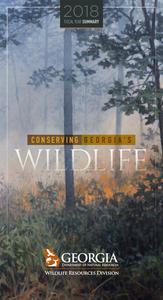2018
FISCAL YEAR SUMMARY
CONSERVING G E O R G I A' S
WILDLIFE
WHO WE ARE
The Wildlife Conservation Section is part of the Georgia Department of Natural Resources. We changed our section name this year from Nongame to Wildlife to more clearly communicate our focus.
WHAWETDO
Our mission is straightforward and statewide: Conserve and protect animals not hunted or fished for, rare native plants and natural habitats through education, research and management.
WHY IT MATTERS
From bald eagles soaring over river swamps to tri-colored bats roosting in mountain caves, wildlife and wildlands are a vital part of Georgia and our way of life. We must preserve them for future generations.
DNR bat technicians collect samples
CONSERVING
WILDL
IFE
ENGAGI GEOR NG
RESTORING
HABITAT
GIANS
MAKING A
DIFFERENCE
ACE campers
ACCOMPLISHMENTS THIS FISCAL YEAR, THE WILDLIFE CONSERVATION SECTION:
JOINED with other Wildlife Resources Division staff and partners to treat 60,000 DNR-managed acres with prescribed fire, the No. 1 tool for restoring fire-adapted habitats and wildlife that need them.
HELPED increase to nearly 50 the number of protected gopher tortoise populations in Georgia, edging closer to a state-based goal to conserve 65 and keep our state reptile off the Endangered Species list.
LED a nest-box program for southeastern American kestrels that recorded the first nesting upswing in years for our smallest falcon.
REACHED about 120,000 people through DNR regional education centers and camps such as Adventures in Conservation Education and TALON, which immerses teens in ornithology and ecology.
FORGED partnerships to protect and restore privately owned cypress savanna wetlands featuring three of Georgia's 21 known occurrences of the endangered plant Canby's dropwort.
Young gopher tortoise
Robust redhorse on the Ocmulgee
Releasing rescued flatwoods salamanders
RESCUED reticulated flatwoods salamander eggs from drought at Mayhaw WMA, eggs then raised by a conservation partner and returned to Mayhaw in all, a state first for the endangered amphibians.
TEAMED with the U.S. Fish and Wildlife Service on northeast Georgia's Chattooga River for surveys that uncovered what is likely the densest known population of brook floater, a federally petitioned mussel.
BEGAN radio-tracking robust redhorse on the Savannah River and sampled the Ocmulgee to find the first ones seen there in at least three years, part of rangewide work to save these imperiled suckers.
CONDUCTED fieldwork needed for DNR to acquire 20,100 acres expanding eight WMAs and meeting State Wildlife Action Plan priorities to protect rare species and provide public recreation.
Comprehensive report and interactive guide at georgiawildlife.com/conservation/AnnualReport.
DNR crew after Tallulah Gorge prescribed burn
THANK YOU
Dr. Jon Ambrose
Chief, Wildlife Conservation Section
"We can't do this without you. In 2018, support for our mission came in many forms. Nonprofits contributed funds to acquire key conservation lands. Car owners bought eagle and hummingbird license plates. Volunteers helped with prescribed fires, conducted field surveys and cleared invasive plants from natural habitats. At all levels, your support is crucial. Thank you!"
DID YOU State funding makes up less than 5% of the Wildlife Conservation
KNOW Section's research and conservation budget. Instead, we depend largely on fundraisers, grants and donations.
HOW TO
HELP
BUY or RENEW an eagle or hummingbird plate. Each is only $25 more than a standard tag and up to 80% goes directly to wildlife.
DONATE to the Georgia Nongame Wildlife Conservation Fund at gooutdoorsgeorgia.com. Just click "Licenses and Permits" to create a customer account.
CONTRIBUTE through the Wildlife Conservation Fund state income tax checkoff. Learn more at georgiawildlife.com/donations.
PURCHASE a one-day $5 hunting/fishing license. Each sale returns to Georgia wildlife the fee plus about $45 in federal excise taxes paid by hunters and anglers.
VOLUNTEER with DNR and join conservation organizations such as TERN, our friends group. Details at gooutdoorsgeorgia.com and tern.homestead.com.
DNR botanist Lisa Kruse assesses cypress savanna wetland
FINANCIAL OVERVIEW
Donations, earned interest & other income 19% ($415,118)
Income tax checkoff 6% ($129,813)
Professional services (contracts, fees) 11% ($262,740)
REVENUE
TOTAL: $2,134,349
Weekend for Wildlife* 24% ($510,020)
License plates 51% ($1,079,398)
Does not include federal and other grants, or $477,565 in state appropriations for the Wildlife Conservation Section.
*Includes 2017 Weekend for Wildlife revenue from the Georgia Natural Resources Foundation. 2018 event revenue disbursed in fiscal 2019.
EXPENDITURES
TOTAL: $2,429,634
Operations 19%
($471,510)
Personnel 70%
($1,695,384)
Expenditures paid through the Nongame Fund.
NONGAME WILDLIFE CONSERVATION FUND
Listed in millions per year
12 M
11 M
10 M
INCOME
EXPENSES
BALANCE
9 M
8 M
7 M
6 M
5 M
4 M
3 M
2 M
1 M
FY '09 FY '10 FY '11 FY '12 FY '13 FY '14 FY '15 FY '16 FY '17 FY '18
FOLLOW US
Sign up for the free e-newsletter Georgia Wild at georgiawildlife.com
GEORGIA DEPARTMENT OF NATURAL RESOURCES | WILDLIFE RESOURCES DIVISION | WILDLIFE CONSERVATION SECTION
PHOTO CREDITS
COVER: Prescribed fire moving through switchcane at Chattahoochee Fall Line WMA (Philip Juras/philipjuras.com) INSIDE COVER: DNR's Zach Henshaw with prothonotary warbler | Monarch butterfly (Alan Cressler) | Connect to Protect planter at Oconee County Elementary (Shannon Montgomery/UGA) | DNR's Clay George videos white shark feeding on whale carcass All photos are from DNR unless noted.
